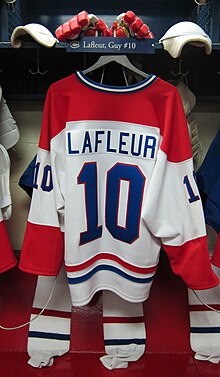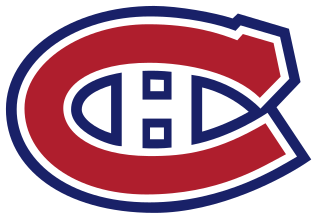
The Montreal Canadiens, officially le Club de hockey Canadien and colloquially known as the Habs, are a professional ice hockey team based in Montreal. The Canadiens compete in the National Hockey League (NHL) as a member of the Atlantic Division of the Eastern Conference. Since 1996, the team has played its home games at Bell Centre, originally known as Molson Centre. The Canadiens previously played at the Montreal Forum, which housed the team for seven decades and all but their first two Stanley Cup championships.
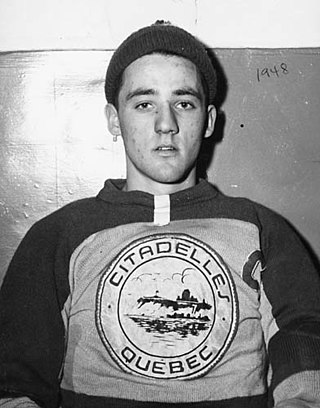
Joseph Jacques Omer Plante was a Canadian professional ice hockey goaltender. During a career lasting from 1947 to 1975, he was considered to be one of the most important innovators in hockey. He played for the Montreal Canadiens from 1953 to 1963; during his tenure, the team won the Stanley Cup six times, including five consecutive wins. In 2017 Plante was named one of the "100 Greatest NHL Players" in history.

Patrick Jacques Roy is a Canadian professional ice hockey coach, executive and former player who is the head coach for the New York Islanders of the National Hockey League (NHL). Roy previously served as head coach for the Colorado Avalanche of the NHL, as well as the Quebec Remparts of the Quebec Major Junior Hockey League (QMJHL). In 2017, he was named one of the 100 Greatest NHL Players in history and was hailed in sports media as "king of goaltenders".
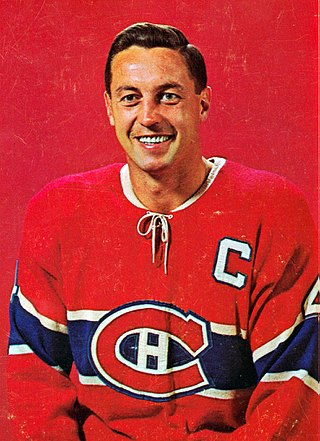
Joseph Jean Arthur Béliveau was a Canadian professional ice hockey player who played parts of 20 seasons with the National Hockey League's (NHL) Montreal Canadiens from 1950 to 1971. Inducted into the Hockey Hall of Fame in 1972, "Le Gros Bill" Béliveau is widely regarded as one of the ten greatest NHL players of all time. Born in Trois-Rivières, Quebec, Béliveau first played professionally in the Quebec Major Hockey League (QMHL). He made his NHL debut with the Canadiens in 1950, but chose to remain in the QMHL full-time until 1953.

Joseph Harry Guy Carbonneau is a Canadian former professional ice hockey player, coach and executive in the National Hockey League. He was also the president of the Quebec Major Junior Hockey League Chicoutimi Saguenéens. Carbonneau was inducted into the Hockey Hall of Fame in November 2019.
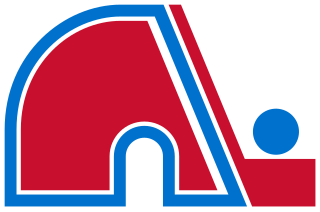
The Quebec Nordiques were a professional ice hockey team based in Quebec City. The Nordiques played in the World Hockey Association (1972–1979) and the National Hockey League (1979–1995). The franchise was relocated to Denver in May 1995 and renamed the Colorado Avalanche. They played their home games at the Colisée de Québec from 1972 to 1995.
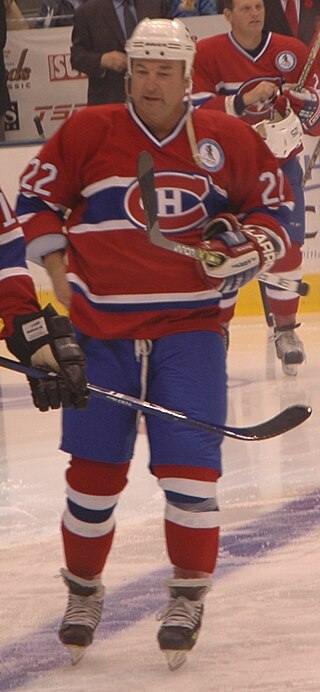
Stephen John Shutt is a Canadian former professional ice hockey player and NHL Hall of Famer who played 13 seasons in the National Hockey League (NHL), 12 seasons for the Montreal Canadiens and 1 season for the Los Angeles Kings. He is in the Hockey Hall of Fame. While playing for the Canadiens he captured 5 Stanley Cups in 1973, 1976, 1977, 1978, and 1979.

Mats Torsten Näslund, nicknamed "Le Petit Viking", is a Swedish former ice hockey player. He played as a left winger. Despite his small size at only five feet and seven inches, Näslund is best known for being one of the top forwards with the National Hockey League's Montreal Canadiens from 1982 to 1990. In addition to the Canadiens, Näslund played for Timrå IK, Brynäs IF, and Malmö IF of the Swedish Elite League, and HC Lugano of the National League A between 1975 and 1994. He made a short NHL comeback attempt in 1995 with the Boston Bruins following the 1994–95 NHL lockout, and retired after the season's conclusion.

Daniel Leo Gallivan was a Canadian radio and television broadcaster and sportscaster.

Gilbert Perreault is a Canadian former professional ice hockey centre who played for 17 seasons with the National Hockey League's Buffalo Sabres. He was the first draft pick of the Sabres in their inaugural season in the NHL. He is well known as the centre man for the prolific trio of Sabres forwards known as The French Connection. The trio helped the Sabres reach the 1975 Stanley Cup Finals.
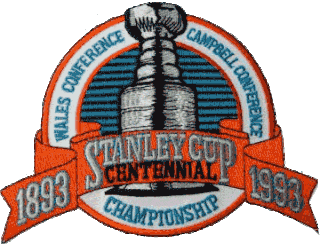
The 1993 Stanley Cup Finals was the championship series of the National Hockey League's (NHL) 1992–93 season, and the culmination of the 1993 Stanley Cup playoffs. It was contested between the Los Angeles Kings and the Montreal Canadiens. It was the first appearance in the Final for the Kings and the first appearance since the 1920 Stanley Cup Finals for a team based on the west coast of the United States. It was also the 34th appearance for Montreal, their first since the 1989 Stanley Cup Finals. The Canadiens defeated the Kings in five games to win the team's 24th Stanley Cup. The year 1993 was the 100th anniversary of the first awarding of the Stanley Cup in 1893, and the first Finals to start in the month of June. To date, the 1993 Canadiens are the last Stanley Cup championship team to be composed solely of North American-born players, and the last Canadian team to win the Stanley Cup.
Guy Gerard Lapointe is a Canadian former professional ice hockey defenceman who played for the Montreal Canadiens, St. Louis Blues and Boston Bruins in the National Hockey League. He retired in 2020 after serving as Coordinator of Amateur Scouting with the NHL's Minnesota Wild for 20 years.
Joseph Francis Richard Sévigny is a Canadian former professional ice hockey goaltender who played for the Montreal Canadiens and Quebec Nordiques in the National Hockey League. He then moved to France to be coach of Chamonix HC (1989–90), Diables Rouges de Briançon (1990–91) and Angers (1994–95), and then returned to the Ligue Nord-Américaine de Hockey. He is noted for being the last Montreal Canadien to wear #33 prior to Patrick Roy.

Joseph Henri Jean-Claude Tremblay was a Canadian professional ice hockey defenceman for the Montreal Canadiens of the National Hockey League (NHL) and the Quebec Nordiques of the World Hockey Association (WHA), notable for play-making and defensive skills.
Joseph Gérard Marquis Tardif is a Canadian former professional ice hockey left winger who played in both the National Hockey League (NHL) and the World Hockey Association (WHA), principally for the Quebec Nordiques, and is the all-time leading goal scorer in the WHA.
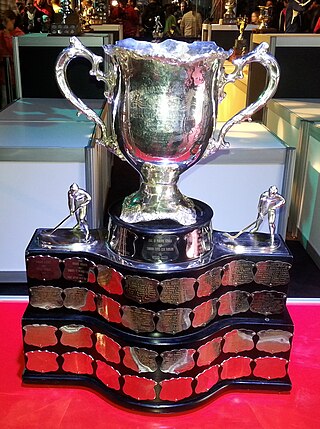
The 1971 Memorial Cup was the 53rd annual Memorial Cup competition, organized by the Canadian Amateur Hockey Association (CAHA) to determine the champion of major junior A ice hockey. It was a best-of-three series between the Quebec Remparts of the Quebec Major Junior Hockey League (QMJHL) and the Edmonton Oil Kings of the Western Canada Hockey League (WCHL). Quebec won the series in two games, both held at the Colisée de Québec, to win the first Memorial Cup championship in the city's history.
François Lacombe is a Canadian former professional ice hockey defenceman, who played in the National Hockey League (NHL) and World Hockey Association (WHA) between 1968 and 1980. He spent parts of three seasons in the NHL with the Oakland Seals and Buffalo Sabres before moving to the WHA and playing for the Quebec Nordiques and Calgary Cowboys, playing briefly for the Nordiques again when they joined the NHL.

The Montreal Canadiens ice hockey club, formally Le Club de Hockey Canadien, was founded on December 4, 1909. The Canadiens are the oldest professional hockey franchise in the world. Created as a founding member of the National Hockey Association (NHA) with the aim of appealing to Montreal's francophone population, the Canadiens played their first game on January 5, 1910, and captured their first Stanley Cup in 1916. The team left the NHA and helped found the National Hockey League (NHL) in 1917. They returned to the Stanley Cup Finals in 1919, but their series against the Seattle Metropolitans was cancelled without a winner due to the Spanish flu pandemic that killed defenceman Joe Hall. The Canadiens have won the Stanley Cup 24 times: once while part of the National Hockey Association (NHA), and 23 times as members of the NHL. With 24 NHL titles overall, they are the most successful team in league history.
In ice hockey, the Good Friday Massacre was a second-round playoff match-up during the 1984 Stanley Cup playoffs. The game occurred on Good Friday, April 20, 1984, in Montreal, Quebec, Canada, between the Quebec Nordiques and the Montreal Canadiens. It is notable less for its series-ending finish than its epic brawl between the players, which spanned multiple periods and resulted in 11 ejections and 252 penalty minutes. It was the most infamous episode of the Battle of Quebec.
The following is a chronicle of events during the year 1977 in ice hockey.



